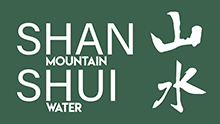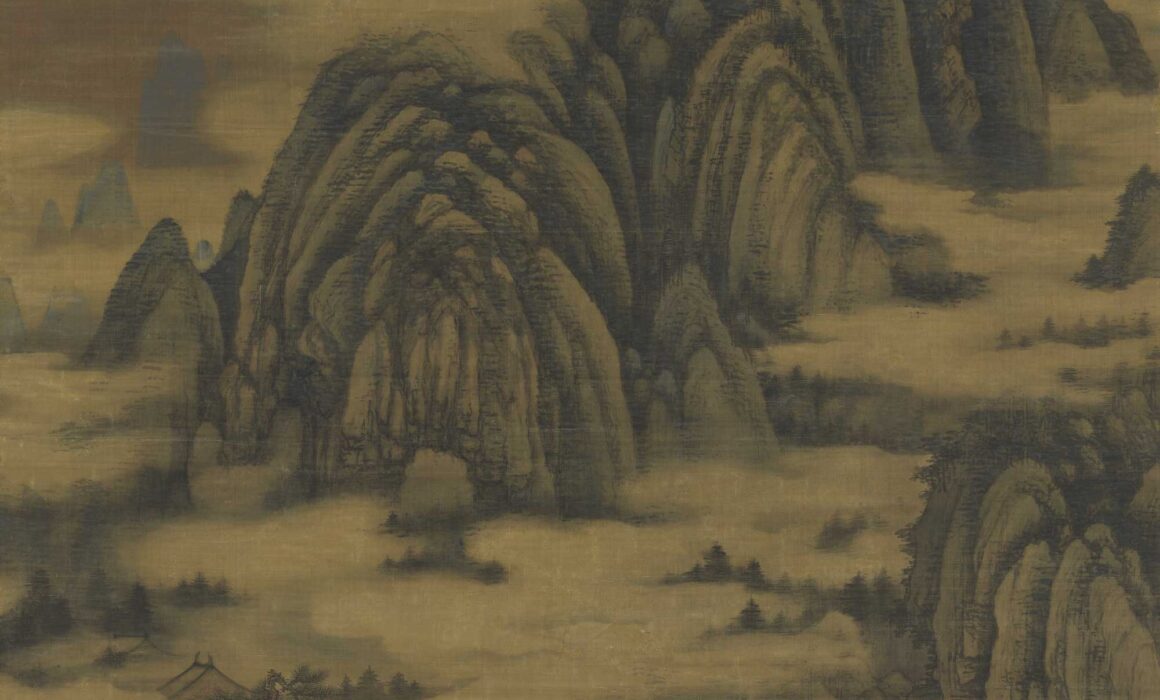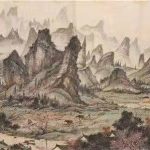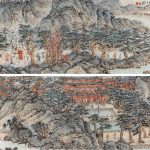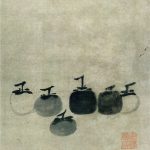Notes from an interview with Maurizio Paolillo
Issue 3 – By; Davide Carnicella
An interwiev with Professor Maurizio Paolillo, who teaches Chinese language and philology at the department of Asian, Africa and Mediterranean studies in ‘‘L’Orientale’’ University of Naples.
His studies are focused on traditional Chinese philosophical and religious sources and his domains of expertise are Chinese literature on the pictorial aesthetics from the 5th to the 11th century, Daoist sources, the Fengshui 风水 texts from the 8th to the 12th century, the sources on the traditional gardens and the ones on Nestorianism in China from the 12th to the 14th century. His contribution to the Academia in these fields has been extremely prolific and the most remarkable publications for our purpose are: Daoism. History, doctrines and practices (Daoismo. Storia, dottrine e pratiche) 2014, Physical and metaphysical landscapes in Eastern and Western literature (Paesaggi fisici e metafisici nelle letterature d’oriente e d’occidente) 2019, which has been edited by him, but there is a broad variety of publications among books and articles worth reading.
It should be pointed out to the reader that Professor Paolillo is a guest editor for the new issue of Sulla via del Catai, a scientific review of the “Centro studi Martino Martini”. The main theme is the flora in China and Professor Paolillo contributed with an essay on Li Deyu’s Pingquan mountain villa. In this essay, he discusses Li Deyu’s interest in the description of the various botanical species he collected in southern and south-eastern China, which he placed in his villa in Pingquan 平泉. This villa was the result of his project to reproduce a large scale landscape along the shores of the Yangzi river 20 km far from Luoyang 洛阳, the other historically important capital, being Chang’ An 长安 (today Xi’an 西安) the capital of the Tang dynasty. The classical quotations in this treatise refer to the ancient treatises on botany, the poet of the Warring states period Qu Yuan 屈原, the Book of Odes 《诗经》, the prose-poem Returning home
《归去来兮辞》 by Tao Yuanming 陶渊明 and the Daodejing 《道德经》 for the theme of the retreat and thus of the knowledge of the world without leaving the room.
By taking the spark offered by this last theme, we considered the “Journey in the room” 卧游 which Zong Bing 宗炳 asserts in the 5th century referring to the effect his shanshui hua 山水画, mountain and water paintings had on him. Professor Paolillo argued that beyond the romantic view of this theme, as well as of the “Free wandering” 逍遥游, this theme represents an extremely precise condition. You游, literally translated as journey, from a doctrinal point of view, consists in the ability of being unfettered from spatial determinations. It is not a simple status dictated by the instinct, but it is a condition in which the subject frees the self from these spatial determinations.
This condition is strictly bound to the ‘‘inaction’’ 无为 and to the “self-generated” or “nature” 自然. The first, parallel to the “non-commitment” 无事 is attained by the identification of the self with the Dao 道. The means through which this is made possible is an absolute practice, valuable in painting too, which arises an attitude of absolute freedom. The “non-commitment” is also supported and explained by Mencius with the metaphor of the flood control realized by Yu the Great 大禹, commenting that Yu’s virtue was that he put in place his “non-commitment”; in other words, this means that he was not attached to any consequence.
All the classical texts do not make any critique on the creative action, one of the main suggestion they provide is that people should not consider their self as a thing. Concerning the practice of the internal alchemy 内丹, Song Dynasty Zhang Boduan 张伯端 clearly states that most of the people begin by the action 有为, but the key corresponds to the detachment that brings to the free wondering 游. There is an excerpt in the Neiye 内业, translated as “Inward training” which focuses on this aspect referring to meditative practices and to the Shen 神, today it is translated as “spirit”, but in this case this translation should not be this one, and its descent after having cleaned the “quiet residence” of the mind/heart 心.
At this point, it seemed interesting to draw attention to the microcosm of the human body in relation to shanshui. The literary tradition on this concern dates back at least to the first Century CE and plunges its roots in the “inner landscape” 内经图.
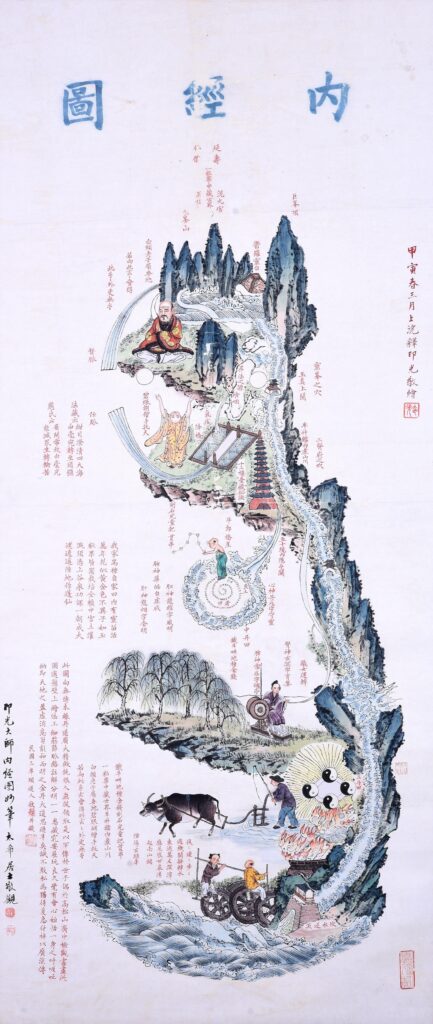
Several references provide us with an interior topography which actually matches the psycho-physical system of the human body, but they still have to be interpreted in a symbolic way. For example, the Book of Laozi’s centre《老子中经》 of the third Century or the Classic of the yellow court 《黄庭经》, among the others, presents the basis for the representation of the human body. These are a fundamental support for Taoist visualization and meditation, which, contrary to the common knowledge, have a very practical application. Isabelle Robinet explains that the body is the first element to focus on during the practices, so the visualization is essentially a technique.
This technique does not only focus on the internal sphere of the body, but it extends also to the external world. The sacred landscape of the Kunlun Mountains 昆仑山, which was considered as the “Axis mundi” between Heart and Heaven, as well as the residence of the immortals and of the Queen mother of the West 西王母 corresponds, in the human body, to the top of head where the “Clay ball” 泥丸 is placed. This, in Daoist alchemy can be seen as a sort of philosopher’s stone in European tradition.
Another aspect of the relationship between the inner body and the external world can be the “Grotto-heaven” 洞天.
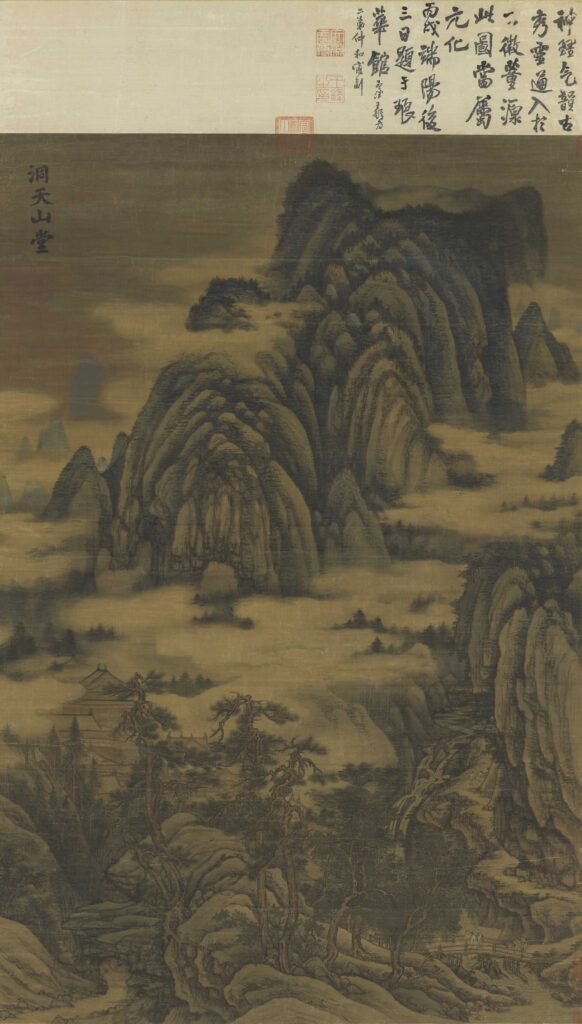
It should be noted that the first step of the establishment of the relation is often the internal realm. In this case, the various spiritual states of the man are represented through specific geographical places in ancient China. The contradictory term “Grotto-heaven” symbolizes a second birth reminding the uterus and it is similar in a certain way to the function of the grotto in Jesus’ birth and in Hinduist Avatar. Additionally, in ancient China and Japan, some rites were celebrated in caverns and the function consisted of drinking water from the stalactites which were seen a human breast, but this is supposedly not directly linked to the “Grotto-heavens”.
The concept of the “Grotto-heaven” dates back to the Wei Jin period and according to different beliefs, there were 10 or 36 “Grotto-heavens” in China. As for the Shanshui, Jing Hao 荆浩 was particularly bound to the belief of the 10 “Grotto-heavens” and his whole work is influenced by it. In fact, the Bifa ji 《笔法记》 begins with the discovery of a grotto and then continues with the encounter with a hermit who imparts the knowledge of painting. It is worthy to note the fact that Jing Hao evaluates Sima Chengzhen 司马承祯, the author of the Zuowangun 《坐忘论》, a Taoist meditative practice, as one of the best painters ever existed.
As for the Bifa ji, specific studies on it are accurate on its literary aspects, but neglect its evocative side. The opening part has old influences and recalls the Record of the peach blossom spring 《桃花源记》 by Tao Yuanming which narrates the story of a fisherman who gets lost and then finally finds himself in front of an opening on the flank of a mountain. He enters this tunnel which eventually leads to another world. This is a common topic in painting and it is represented through a mountain and a blossoming peach tree, but these never represent the new world. This last example, which stems from Taoist tradition, is one of many. Alongside, the preeminence of the internal realm stated in the Taoist doctrinal sources and in the concepts of the “Grotto-heavens” provide a fertile field which supplies the pictorial production.
Eventually, linking this discourse to the one of the free wandering, when Song dynasty Guo Ruoxu 郭若虚 talks about the Qiyun 气韵, translated as “consonance of the qi”, he says:
Generally, in painting, the “Qiyun” takes root in the “wandering of the earth” 游心; the ornamental expression of the spirit 神彩 is born from the use of the brush […]. This is why the idea/intention 意 pre-exists the brush: the brush will circulate, and the idea will be interior. The work will be perfect, the idea/intention will be present. The image will be in consonance, the spirit will be complete. Hence, what is interior is sufficient by itself and as a consequence the spirit will be detached and the idea/intention established: thus the thought 思 will not exhaust and the brush will not get tired.
Closing the discussion of the topic with Guo Ruoxu’s quotation, the conversation dealt with the problem of the taboo of the comparative method. Professor Paolillo tackled this subject in his essay I principi estetici nella teoria pittorica della Cina antica: per un superamento del tabù comparativo (Aesthetical principles in ancient chinese painting theory: going beyond the comparative taboo). This theme casts a shadow on intercultural communication between China and Europe in a particular way, but it may be extended to other areas. The panorama presents two opposite tendencies that are supported by prestigious personalities. The first one may be represented by François Jullien, who believes Chinese thought to be “other” and the second is the approach which sees Chinese thought as an absolute point of reference in contrast to European thought.
Professor Paolillo, on the other hand, considers that cultural correspondences may be very positive, but in order to establish them, it is necessary to know the sources of both the cultures very well. He further asserts that both previously mentioned positions derive from the lack of knowledge of one or of the other tradition.
When asked to find a parallel between shanshui paintings and other forms of art, Professor Paolillo elicited an extremely insightful reasoning. He first admitted the unique peculiarity of this artistic production, and then took into account the need for human beings to represent the self through a place. As a matter of fact, likeness in literature and painting there may be found. The action of the artist to show the internal realm by means of representing a place on a medium is a primordial need. In this concern, shanshui may be seen as a reaction to this human need. A message, in order to be imparted, needs space, like a sound wave: there is no sound in the void. For this reason, it is fundamental to paint a space and Chinese culture responded to this primordial necessity by representing the self in an ideal situation through spatial references. In this sense shanshui is an extremely valuable human heritage.
Finally, a suggestion that Professor Paolillo gives to painters who do not have a traditional Chinese artistic education is to examine in depth the concept of “true” 真, as it is considered in the Bifa ji. The main reason why he says this concept is not limited to the shanshui, but it is a method through which it is possible to see the world and enhance an internal work. Although this quest is dependent upon certain canons, this is the way to reach a creative freedom. This is the real secret which lies behind any poietic deed.
Read the full magazine
